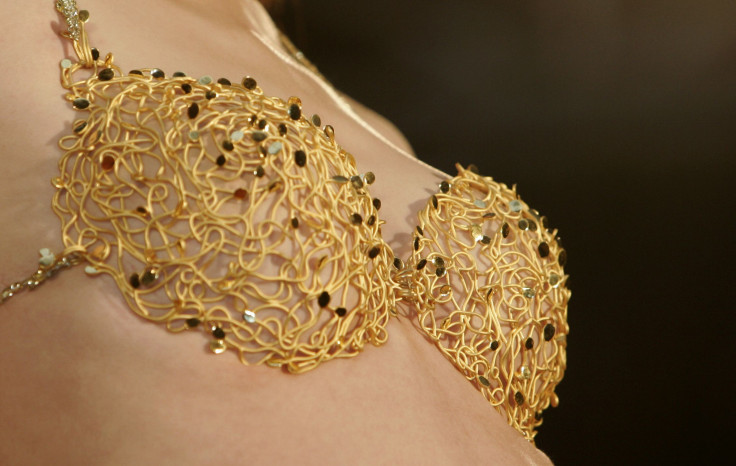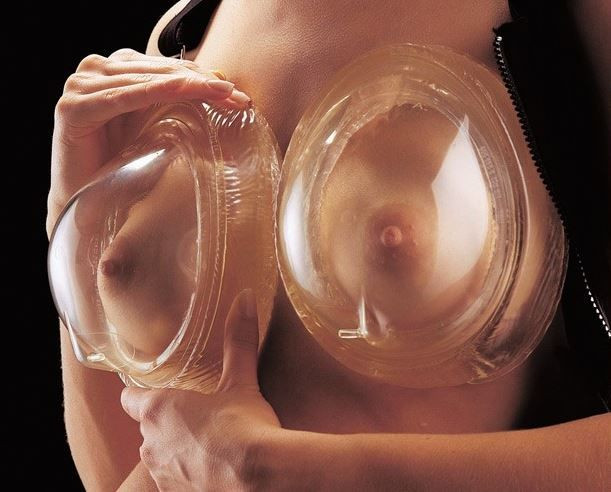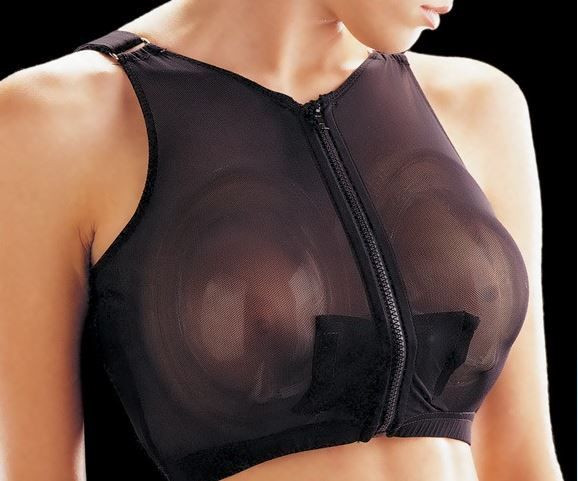A Boob Job Minus The Surgery? A Look At Alternative Breast Enlargement Products

America worships big breasts. A glance at TV, websites, magazine racks, and neighborhood billboards reveals boobs, boobs, and more boobs. Everywhere, we see cleavage spilling out of bras, swimsuits, and low-cut, strategically arranged garments. If media is not to be trusted then take a gander at the latest cosmetic surgery statistics. In 2014 alone, nearly 300,000 women (including teens) went under the knife to enlarge their breasts with implants.
Beyond the media or surgical stats, a woman simply needs to recall her own middle school years to understand the true power of breasts. As a member of the common herd, we all learned which traits (in both boys and girls) were in high demand, and big breasts inevitably made that list. It didn’t matter that only the mean girls and boys made any actual comments, there was attention paid, smiles exchanged, and giggles spreading, even among the “nice kids.” How everyday, then, for a woman who is not well-endowed (and also does not live under a rock) to feel second-rate despite the many well-meaning family and friends who say “it doesn’t matter,” “you’re still attractive,” or even, this most unlikely stretching of the truth, “you’re lucky.”
“I think they are full of sh--,” wrote filmmaker Nora Ephron of such supportive comrades in her essay, "A Few Words About Breasts." She said, “I cannot shake it, cannot shake my feelings of inadequacy.”
While the insecurities of one successful writer does not make an argument, the number of products and procedures marketed to exploit such feelings suggests Ephron is far from alone. There's a great deal of money to be made by promising women bigger boobs; apparently, cosmetic surgery is just the tip of the iceberg. With plenty already written about that particular product, Medical Daily will instead review, in a general way, the nonsurgical breast products available today. Conveniently, the bulk of them fall into three basic categories.
Nutritional and Other Natural Products
An estimated 50,000 nutritional supplements are currently available, according to The Natural Products Association (NPA), and more than a few of these are marketed as breast enlarging products.
“Anyone can sell a supplement, it’s very easy to do,” Dr. Tod Cooperman, president of ConsumerLab, which identifies quality health and nutritional products through independent testing, told Medical Daily. While the Food and Drug Administration is responsible for taking action against any adulterated or misbranded supplement after it reaches market, it does not approve each individual supplement. Essentially, then, a product is good to go as long as it contains only dietary ingredients (defined by the FDA) and its label lists all ingredients correctly.
Typically, breast enhancing products contain a variety of herbs, which fall into four general categories, described by ConsumerLab as:
- phytoestrogens, including soy, red clover, flaxseed, fennel, hops, and other herbs;
- traditional aphrodisiacs such as damiana and oat straw;
- generic ‘women’s herbs’ including motherwort, blessed thistle, black cohosh, and chasteberry;
- and miscellaneous herbs, such as palmetto and wild Mexican yam.
According to Cooperman, there’s, at best, only tangential science supporting most of the above supplements. All told, phytoestrogens present the most convincing case. These natural plant products mimic the effects of estrogen, a hormone known to increase breast size. While that sounds like a winner, by taking a supplement with phytoestrogens, women may be blocking their natural estrogen, which is more powerful. There’s the very real possibility, Cooperman explained, that these supplements might suppress growth, instead of encourage it, in pre-menopausal women.
Evidence from the scientific literature support his position. One recent study cited by the Mayo Clinic showed no evidence that phytoestrogen increased breast tissue density or growth. Meanwhile in another study of herbal compounds, Dr. A. Fugh-Berman of George Washington University neatly concluded, “The use of bust-enhancing products should be discouraged because of lack of evidence for efficacy and long-term safety concerns.”
The products not only fail to work, but Canadian researchers who conducted an investigation of 44 herbal products produced by 12 different companies found that more than half contained unlisted ingredients. A serious label-reading woman, then, might kick off an allergy by taking these products. Worse still, some supplements could trigger a serious drug interaction, warns the Mayo Clinic, especially in women taking blood-thinning medications such as warfarin.
What about all the natural creams and lotions and gels — do those work? According to The Natural Center for Health Research, these products similarly do not fulfill their claims, ointments intended to be massaged into the breast are simply another scam for reaping profits. Quoting the FDA, the Center noted: “For decades, millions of dollars have been spent on devices, creams, and lotions advertised as breast developers, all wasted."
Suction Cups and Other Devices
Among breast enlarging devices, Brava Breast Enhancement and Shaping System (more commonly referred to as the 'Brava Bra') is possibly the best known. As described on the company's website, “The BRAVA Starter System consists of two semi-rigid domes, with specially engineered silicone gel rims, and a sophisticated minicomputer, called a SmartBox, that creates and regulates the tension within the domes. A sports bra is also included, to hold the domes and the SmartBox in place.”
Say what? In layman’s terms, the Brava system is a suction cup device worn like a bra. This “brassiere-like system” as it is described in one study, “applies a 20-mmHg vacuum distraction force to each breast for 10 to 12 hours/day over a 10-week period.” Basically, the suction cups exert a continuous pressure, causing the breast tissue to gradually, slowly expand over time.

While this may sound reasonable, only limited scientific support exists for the Brava system. The results from one 2007 study involving 50 women indicated 30 women found satisfaction with their results. “Long-term breast enlargement without surgery is possible with an external tissue expander,” noted the authors. (This study is quoted frequently on the Brava website.) Another study of 17 women found “daily use of an appropriately designed external expansion system” to be “effective and well-tolerated.” However, one of the authors of this study, Dr. R. K. Khouri, is the inventor of Brava system, according to the Miami Breast Center.

On RealSelf.com, a website devoted to raising and answering health and beauty questions, the reports from impartial doctors are more skeptical. Some claim the results are negligible, while others say any results will be temporary, gradually lessening over time. Another online forum, WeWomen.com, voices the opinions of “real” women who give the product mixed reviews. One positive response is glowing, while another woman claimed the growth she achieved disappeared over time.
That said, unlike supplements, there are no real health risks with the Brava Bra (when used properly), other than, possibly chafing skin (where the dome meets your skin) and sleepless nights. If you’ve got money to burn, lots of time, and more than your fair share of patience, this might be worth a no-expectations-try.
Fat Grafting
Finally, we arrive at fat grafting, also known as autologous fat transfer, a procedure where fat tissue is removed by liposuction and then processed and injected back into the breast area. Since removing unwanted fat from one part of your body and inserting it directly into your boobs is basically a dream come true for many women, fat grafting has been widely adopted in both plastic and reconstructive surgery.
“Fat is an appealing filler material for it is biocompatible, is abundantly available, can be easily harvested and processed, and can be injected in controlled amounts,” wrote the authors of a Loma Linda University Medical Center study published earlier this year. More importantly for consumers, unlike surgical implants, fat feels soft and natural to the touch.
Despite such obvious benefits, though, challenges and concerns exist. One issue is that fat grafting often takes up to four hours, while the recovery period may take two weeks or more. Then there's safety.
“It can be tempting to think about fat grafting as a 'safer' procedure, since it doesn’t involve major surgery,” BreastCancerOrg states on its website; however, some doctors have theorized the procedure could raise the risk of breast cancer. That said, the organization notes that no large clinical studies have been conducted, with the current research tracking fewer than 100 women for less than four years.
While the long-term safety profile is not yet known, the aesthetic result also remains difficult to predict.
“Obtaining predictable, reliable, and consistent outcomes remains a significant challenge,” wrote the Loma Linda researchers, who added that as much as 40 to 60 percent of the volume of fat injected could be lost due to necrosis (tissue death) or resorption by the body. Interestingly, some doctors combine a Brava-like suction method with fat grafting, claiming it gives optimal results. In one study of 12 women, the authors found that pre-expansion of the breast tissue allowed for greater grafting volume with “reproducible, long-lasting results” in less than two hours.
In the end, there are three general options available to a woman seeking non-surgical breast enlargement. All cost a pretty penny, some pose health risks, and not one method can be whole-heartedly recommended by the scientific community. Still feeling inadequate and wanting to change? Do the research and proceed with caution.



























